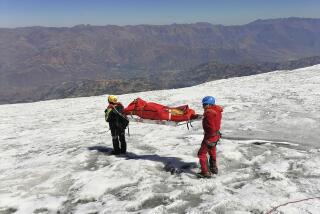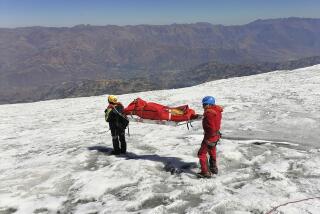Dealing With Artifacts of Everest Climber Mallory Poses New Challenge
- Share via
TACOMA, Wash. — A handkerchief of burgundy and blue, wrinkled and stained, monogrammed with the initials GLM. A pair of goggles, their green-tinted lenses scratched, the silver frame bent on one side. The rope that probably killed him when it broke, frayed horribly at one end. These are the things that came down from Mt. Everest when George Mallory did not.
Spread out on a table at Washington’s State Museum of History in their first U.S. display, the contents of the legendary British mountain climber’s pockets are what remain of the ill-fated 1924 expedition that might have been, but probably was not, the first ascent of the world’s highest peak.
Now, leaders of the May expedition that located Mallory’s body shrouded in snow 27,000 feet up the mountain are attempting to determine what should become of the mementos they brought down: the altimeter, pocket knife, scissors and packet of beef bouillon lozenges found in his pocket, a spent canister of oxygen, a list of camp supplies, the three letters from family members--and an unknown woman--wrapped carefully in a pocket near his heart.
“It’s just kind of amazing to think that George was blowing his nose in this,” Eric Simonson, the Ashford, Wash., mountaineer who led the quest for Mallory, said Friday as he held the crumpled handkerchief, now safely encased in a plastic bag.
Expedition leaders have deposited the artifacts for safekeeping at the Tacoma museum, home of a major exhibition on one of America’s premier climbing mountains, Mt. Rainier. Now, with interest in displaying and publishing the finds all over the world, the owners of the property must be determined and a plan for exhibiting them decided.
Already, Mallory’s son has expressed anger that a photograph of the dead climber--his muscled white back exposed to the air from 75 years of hellish winds ripping at his clothes--was sold and published. The proceeds, expedition leaders say, will go to Himalayan charities.
The letters found in Mallory’s pocket, one from a sister, one from a brother, and a third originally thought to be from his wife but now believed to have been written by another, unidentified, woman, could present a dilemma for determining ownership.
Since they were found in Tibet, does 1924 Tibet copyright law apply, Simonson mused? Or the law of Britain, from which Mallory hailed? Or South Africa or California, where his heirs reside?
“An intellectual property lawyer would have a field day with this, because he could possibly bill for the next 20 years researching it,” Simonson said.
The one question that the expedition had hoped to answer--did the 38-year-old British schoolteacher and his 22-year-old climbing companion, Cambridge student Andrew Irvine, make it to the top?--wasn’t. The camera that might have documented a summit ascent was never found.
Some who have looked at the available evidence now believe it is still possible the pair reached Everest’s summit 29 years before Edmund Hillary and Tenzing Norgay were credited with its first official ascent in May 1953.
But Simonson and several of his climbing partners believe otherwise. One of the goals of the expedition was to determine whether the formidable Second Step, a sheer wall of rock and ice near the summit now equipped with a ladder, could have been climbed by someone like Mallory with limited gear and no way of finding the only possible route up it.
Simonson expedition member David Hahn helped a partner free climb the dreaded passage, without ladder or ropes, and it was indeed possible. But that was only because they started early in the day and knew in advance which was the correct ascent route, he said.
Hahn came away doubting that Mallory could have climbed that face, an equally challenging one below it and the difficult traverse between the two--not as late in the day as he is believed to have begun his ascent from camp at 27,000 feet.
Indeed, the evidence suggests that Mallory and Irvine were roped together and took a fall that sliced through the rope, hurtling both their bodies back toward camp level. Mallory’s waist was bruised and cut where the rope violently twisted around him, but his injuries were not severe enough to suggest he fell very far, Hahn said.
All of this has required a bit of emotional reassembly for Clare Millikan, the 83-year-old daughter of Mallory who lives in Santa Rosa, Calif., and who always had assumed her father had died peacefully.
“Since this occasion, I’ve thought about it more and more, and wondered if retroactively someone can look back through time and comfort someone as they’re dying. He must have been in some pain lying there, with his leg broken, sort of holding his hands out,” Millikan said. “All these years, I had rather hoped he would be like the Ice Man, and he would be there sort of leaning against a rock and going to sleep against the cold.”
Millikan never knew her father well. He was off at war in her early years, then on a series of expeditions to Everest. But she became a climber herself, going on frequent rock-climbing trips into Wales and the Lake District of England, and a climbing trip to the Alps.
With her American husband, a medical school professor and amateur climber, she wandered the American West, stopping for short climbing excursions, “lying by creeks and reading Shakespeare by day.” On one trip, as the couple climbed with several other people in Tennessee, her husband was scaling a sheer rock face and was killed instantly when a boulder slammed into his head.
They had been married 8 1/2 years. They had two children, the youngest just 2. Millikan felt for her husband’s pulse, waited till his body grew cold. The only consolation was that, coming home, she knew what to say to her children. She had heard it from her own mother. “Your father is dead, and he will never come back.”
And so Mallory is. The handkerchief came back, and the letters, the altimeter, the watch. But the man himself, Simonson and the others covered with rocks so his body wouldn’t be found again. They never did see his face, frozen as it was into the snow. Did it look triumphant? Frightened? In pain? That was a riddle that didn’t need an answer.
More to Read
Sign up for The Wild
We’ll help you find the best places to hike, bike and run, as well as the perfect silent spots for meditation and yoga.
You may occasionally receive promotional content from the Los Angeles Times.






